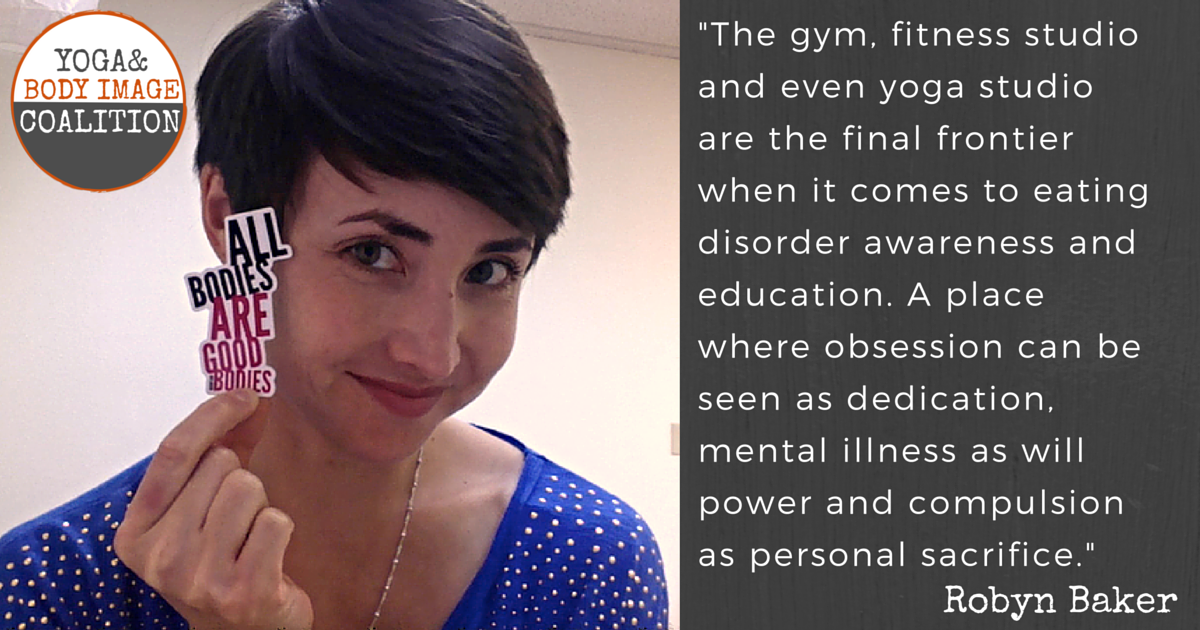Hiding Behind Healthy, by Robyn Baker
June 6, 2016
“Hiding Behind Healthy”
Exercise can be the Perfect Hiding Place for Eating Disorders and This Needs to Change
Over the past few decades the exercise and fitness boom has gained undeniable momentum as it has spread across the United States and across the world. With high tech gadgets that keep track of how many stairs, miles and steps one has logged within a day, to virtual fitness classes when a fitness studio or gym is nowhere in sight, accessibility to various forms of exercise as well as an endless barrage of information regarding the body’s daily (and up to the minute) activities is literally at our fingertips. Exercise advice and “rules” abound on the internet. Celebrity trainers who promise incredible physical transformations highlighted with glossy before-and-after photos gain notoriety as they celebrate their famous clients who had the so-called will power and dedication to get in “top Hollywood-shape”. Across the world, “getting fit” has not only become a way of life to be revered but also a behavior to be looked upon as virtuous, noble and (most importantly for the success of the fitness industry) difficult to attain. But as important and, at times, healthy as regular exercise can be for the majority of the population, the exercise and fitness world is also a very acceptable arena and perfect hiding place for eating disorder behaviors. The gym, fitness studio and even yoga studio are the final frontier when it comes to eating disorder awareness and education. A place where obsession can be seen as dedication, mental illness as will power and compulsion as personal sacrifice.

For those struggling with an eating disorder, approximately 55% exhibit some form of compulsive exercise. Yes, that’s more than half. And because food does not play a staring role in an exercise addiction or compulsion, self-destructive eating disorder behaviors can easily fly under the radar of many well-intended doctors, even those specializing in eating disorder treatment. Even more worrisome about this destructive entanglement of eating disorders and exercise behaviors is how the exercise community and fitness industry can unknowingly celebrate and even covet the people that are deeply suffering. How do I know this? I used to be one of them. With my weight at dangerously low levels, brittle bones, years of cessation from menstruation and a cloudy, absent stare filling the void in my eyes, I was never short of hearing the encouraging words of fitness professionals telling me how they wished they had my body, how amazing I looked and how lucky I was to have such dedication and will power to push myself to perfection.
With the majority of any developed country’s population falling under the category of “inactive”, consistent physical activity is something most people aspire to achieve and most people end up spending a lot of money on trainers, services and programs hoping to make exercise a permanent part of their lifestyle. Just like falling into the privileged classification of “skinny”, being in shape and obtaining a body deemed by society as ‘fit” has become one of the ultimate body achievements as we are sold the notion that you can never be “too in shape”. An eating disorder is sneaky and can easily justify an obsessive exercise habit as healthy, an improvement to ones body image or a way to deal with stress. All of these may be perfectly healthy reasons to exercise for someone who isn’t struggling with an eating disorder, but for someone who is struggling, they are anything but.
Many medical practitioners working with eating disorder patients tend to zero in on food and eating behaviors during the treatment process, which can create a blind spot were harmful exercise habits are easily overlooked and can possibly evolve into something just as destructive and dangerous as behaviors surrounding food. And without proper awareness and sound education within the fitness community, compulsive exercise habits inspired by ones eating disorder are seldom addressed (if noticed at all) or dismissed as not a major concern.
“How could anyone ever do too much exercise?”
“There are worse things one could be addicted to, don’t worry so much.”
“I wish I had your problem with exercise! You’re so lucky! I can never get myself to workout like you do.”
Change needs to happen in the fitness industry and it needs to happen now.
First we need awareness within the fitness community. This includes establishing some kind of dialogue amongst fitness professionals regarding eating disorders. Openly discussing eating disorders, what they are and how they develop, is crucial. Sadly, there is a huge lack of understanding (and willingness to understand) within the fitness community and this is a serious problem. While groups and movements such as the Yoga and Body Image Coalition and The Moderation Movement have begun this conversation, there is still much more work that needs to be done in order to bring awareness to this community of professionals. An increase in eating disorder awareness would help diminish stigma and shame, which unfortunately still heavily surrounds eating disorders. Awareness also includes proper screenings of the fitness professionals themselves who might be struggling with their own eating disorder. Studies have shown that eating disorders are more common for those working within the fitness industry and this can be a liability for fitness facilities and studios not just a danger to customers who also might be struggling with their own illness.
Second, we need responsible education for fitness professionals on how to address someone with an eating disorder as well as compassionate protocols for anyone who may be struggling. There is little to no discussion of eating disorders within any of the nationally or internationally recognized fitness certifications and this also includes Pilates and yoga certifications and trainings. While most teacher trainings and certifications cover basic knowledge of human anatomy, movement anatomy, common injuries and chronic conditions fitness professional might work with in their area of study, mental health is completely left out of the certification and training process. Exercise education companies must begin to recognize that the body and the mind are indeed unified and it is time to stop treating mental illness as something separate from the rest of the body or not impactful to over all physical health. Programs such as Destructively Fit and Yoga for All, which earns fitness professionals and yoga teachers continuing education credits, is something that should be required for all trainers and instructors and not just an optional stand alone course for credits to maintain one’s professional standing. With 30 million people suffering from an eating disorder and an even larger number of the population struggling with negative body image, learning the proper and compassionate ways in which to address someone struggling with an eating disorder and/or negative body image in the exercise environment can no longer be just an option.
Much work needs to be done within the fitness community when it comes to eating disorders and it well may be a very long road ahead before change actually occurs. But with overall eating disorder advocacy and awareness growing in strength, new and incredible programs, books like “Yoga and Body Image” by Anna Guest-Jelly and Melanie Klein, “The Truth About Exercise Addiction” by Katherine Schreiber and social media awareness starting the conversation of the dangers of exercise behaviors and eating disorders, I’m encouraged now more than ever that things are headed in a positive directions and that real change is possible.
Bio:
 Robyn Baker is a certified personal trainer, Pilates instructor and yoga teacher. She holds a BS in Kinesiology, has worked in the fitness industry for over 14 years and is 8 years recovered from anorexia and exercise addiction. She is the owner and operator of Asteya Fitness, a body positive and ED recovery-centered fitness studio in Costa Mesa, California. She also is the creator of the online program, Intuitive Exercise, designed for those in eating disorder recovery looking to find a healthy relationship with exercise and body image. Learn more at www.asteyafitness.com and www.intuitiveexercise.com
Robyn Baker is a certified personal trainer, Pilates instructor and yoga teacher. She holds a BS in Kinesiology, has worked in the fitness industry for over 14 years and is 8 years recovered from anorexia and exercise addiction. She is the owner and operator of Asteya Fitness, a body positive and ED recovery-centered fitness studio in Costa Mesa, California. She also is the creator of the online program, Intuitive Exercise, designed for those in eating disorder recovery looking to find a healthy relationship with exercise and body image. Learn more at www.asteyafitness.com and www.intuitiveexercise.com

So important, this topic!
I find that any addiction comes from unresolved pain.
When one can get into the core of the pain and sit with what ever is there it starts to feel the power of love and light and has the ability to transform.
Melissa Lee